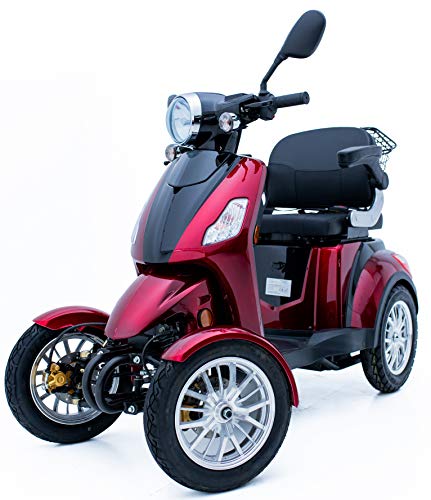Three Of The Biggest Catastrophes In Modern Mobility Solutions History
페이지 정보

본문
 Modern Mobility Solutions
Modern Mobility SolutionsDiscover how innovative technologies are changing the way we travel. These solutions, ranging from electric vehicles to customized services, are changing the way we move.
Find out how optimizing transportation systems can lead to greater efficiency, resulting in less congestion and a more sustainable urban development. Our EMQX MQTT platform is ideal for real-time data exchange across these systems, as it is scalable and designed to support a high volume of devices at the same time.
Electric Mobility
Electric mobility scooters for Sale mobility is the use electricity to power vehicles, such as electric bicycles and buy electric mobility scooter cars. This technology helps to reduce the emission of carbon dioxide and air pollution, as well as offering consumers a safer and more convenient method of travel. The transition to e-mobility isn't without its challenges. Some of these challenges include limit range anxiety, ensuring the availability of a reliable charging infrastructure and minimizing the cost of energy.
In order to address these challenges, solutions are emerging around the world that encourage e-mobility and reduce environmental impact. These solutions include swapping batteries, improving battery technology to increase range, reduce charging times, as well as increasing the number of charging stations. Governments can also incentivize customers to purchase EVs by providing tax credits or subsidies.
The increasing demand from consumers for eco-friendly transport options has led to a boom of new technologies aimed at improving sustainability. This includes mobility-as-a-service, smart parking and traffic management systems, shared electric mobility, and even high-speed adult electric mobility scooter vertical take-off and landing (eVTOL) taxis.
E-mobility is an important part of a broader vision for the future because it reduces congestion and emissions while providing better transportation experiences for urban populations. It will require a major change in the way we travel and an entirely new model of sustainable energy to be beneficial to society.
As a result, it's important to have a clear understanding of the potential dangers and consequences that come with each aspect of this new revolution. This includes the need to take taking into account the impacts on the economy, the environment, and society in general. There are many tools are available to assess the impacts of various technological advancements, including methods for assessing the life cycle of a product.
These tools can help companies make informed decisions about how to invest in e-mobility. By integrating different solutions into their businesses companies can reap the benefits of the e-mobility. This will result in sustainable development for our planet. TUV SUD has a century's worth of experience in automotive safety engineering will provide a full range of assistance to companies on their journey into eMobility. We're your one stop facilitator for the safe integration of 3 wheel electric mobility scooter for adults uk mobility innovations.
Connectivity
In a world where customer experience has become the new benchmark for service, seamless integration is crucial for a successful mobility solution. Learn how integrating connected vehicles into an intelligent system and then deploying them can enhance your business's operations.
The development of shared mobility services has changed the way people travel. These innovative methods of urban transportation provide alternatives to driving and are a promising option for reducing pollution and congestion in cities.
They face significant challenges in becoming a viable alternative for personal vehicle ownership. They include the need for an adequate infrastructure for transport and the necessity of making fares affordable and the application the equity principle which calls for equal access to mobility solutions for all sections of society.
Despite these limitations sharing mobility services have been growing quickly. These solutions rely on data and sophisticated algorithms in order to allow travellers to choose and purchase various transportation options in the same application. They also provide real-time updates and personalised services making them more convenient to use as opposed to traditional methods of commute.
One of the key reasons for the rapid growth in this sector is the increased availability of affordable electric vehicles and charging stations. More and more consumers are opting for these eco-friendly and efficient options. Cities and towns are also investing in green, sustainable transport infrastructures to promote cycling, walking, public transit and sharing vehicles as an alternative to driving.
Micromobility solutions are also that is driving the shift towards sustainable commutes. These lightweight vehicles, usually 3 wheel electric mobility scooters-powered scooters and bikes, are being integrated into urban transportation networks. They provide a last-mile/first-mile solution for commuters and reduce the need for private vehicles.
To overcome these obstacles and ensure the sustainability of micromobility, it's essential that public-private partnerships work together. This is particularly crucial for urban mobility solutions, which require a large investment and have to be tailored to local circumstances. MaaS (mobility as a service) platforms are an example of this that was developed by a mix of urban transport companies technology companies, as well as payment service providers.
Sustainability
Sustainability is a growing concern for modern mobility solutions as both governments and consumers are seeking sustainable transportation alternatives. Find out how seamless integration of transportation modes, real time information, and personalised services can transform the experience of commuters while reducing environmental impact.
Fossil fuel emissions are a major contributor to climate change. These emissions also contribute to pollution in the central city areas and congestion as well as public health issues. By promoting sustainable new mobility solutions, such as walking and cycling, people can benefit from better efficiency in their travel times, as well as an improved quality of life.
Shared vehicles are another method to encourage sustainable mobility. They generate more revenue through passenger fares than they cost to operate. In turn, they are less likely to require the assistance of taxpayers than traditional public transport.
The search for sustainable mobility however, requires a holistic approach that goes beyond reducing automobile traffic and enhancing existing infrastructures. It requires the promotion of sustainable transport alternatives and the re-designing of urban areas to remove private vehicles.
Smart mobility measures can improve the attractiveness of urban spaces and make them more accessible through encouraging a shift towards walking and cycling. They can also improve conditions for public transportation, biking, and telecommuting. They may also incorporate pricing strategies designed to raise the perceived cost of using motorized vehicles, promoting an increase in public and active transportation modes.
The introduction of congestion charges, for example, encourages drivers to think about alternatives other than their own vehicle. Additionally, the use of intelligent road systems can increase the safety and efficiency of vehicles by optimizing the flow of traffic. The use of IoT technology enables vehicles and infrastructure to communicate, allowing for monitoring of driver behaviour in real-time and identifying congestion sources. The data is used to modify the traffic management system accordingly to reduce congestion and improve the overall efficiency of transportation systems. This results in a better quality of life for everyone, with less noise pollution.
Enterprise Mobility
Enterprise mobility is the ability for employees to work anywhere using a variety of devices. This technology includes mobile phones, cloud storage, and applications that enable workers to access their data from anywhere and communicate with their colleagues. Enterprise mobility solutions can improve communication and facilitate more efficient decision-making. They can also help reduce the amount of paper and storage space required. Employees can, for instance upload a presentation to cloud-based storage services via their desktop computer and then access it through an mobile device to present the presentation to clients.
The modern mobility industry is continuously evolving to meet the needs of both businesses and consumers. The increasing concern over sustainability is driving the demand for sustainable transportation alternatives. This can be accomplished by a variety of innovative solutions. Telematics systems, which enable infrastructures and vehicles to communicate and improve traffic flow and reduce congestion, are among these solutions. In addition, these solutions can connect different modes of transportation to offer a seamless and personalized journey.
In the end, all mobility solutions should be designed to improve the lives of customers as well as guests. For example the hotel could benefit by providing its staff with mobile devices that can quickly and easily access guest information. This will allow them to better serve their guests, thus increasing customer satisfaction and loyalty. Similar to that healthcare professionals who can work remotely could offer better care to their patients.
For companies to implement these features, they must invest in enterprise mobile management (EMM). This includes devices and software that can manage the security of business-owned and personal devices, which protect sensitive data from cyber-attacks and provide a pleasant user experience. It also helps companies avoid the high cost of replacing or repairing lost or damaged devices. EMM can also support BYOD initiatives by allowing employees to use their personal devices for work. However, it is crucial to have a clear acceptable use policy in place before adopting EMM. This will set clear expectations for employee behavior and mitigate the risks to security of data.
- 이전글Power Tool Set Deals's History History Of Power Tool Set Deals 25.04.02
- 다음글10 Mobile Apps That Are The Best For Goethe Certificate 25.04.02
댓글목록
등록된 댓글이 없습니다.



 02.6010.5010
02.6010.5010




